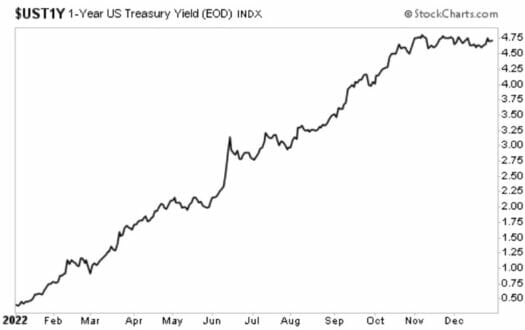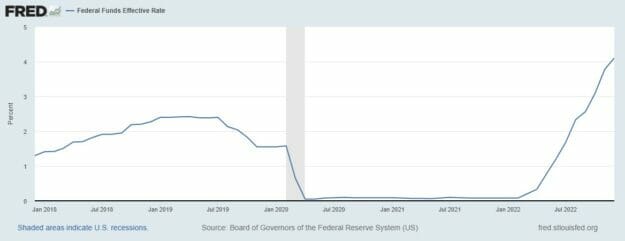More Reasons Why Corporate Bonds Will Rebound In 2023 (And How You Can Profit…)
Yesterday, I wrote that corporate bonds were poised for a major rebound.
There are many reasons for this, but it all boils down to what I said in that piece:
“Last year’s 13% drop doesn’t sound that bad. But in a world where a 3% dip is practically considered bear market territory, this is a 100-year drought.”
Coming off the heels of bad years, bonds historically tend to do quite well. So rather than head for the hills, I think now is time to load up.
I’m not alone in this opinion, either. According to T. Rowe Price, this could be “the most attractive point in years” for bond investors. Barron’s says that after a brutal stretch, “now is the time to buy.” Morningstar agrees that bonds are “poised to rebound.”
Today, I want to dive a little deeper into my case for corporate bonds — and how you can profit.
Now Is The Time To Strike
You might have heard of the term duration, a measure of a bond’s sensitivity to interest rates. Without getting into the math, a duration of 5 simply means that a 1% uptick in rates will cause the price of an existing bond to slide 5%. Likewise, a 1% rate decline could drive the price up by 5%.
But this has been a one-sided game in recent years. Short-term rates couldn’t get any lower – they were anchored near zero. The only possible move was up. That highly asymmetrical risk/reward is one of the reasons I have assiduously avoided bonds and bond funds in our portfolio.
But we’re in a different world today. That hypothetical 1% increase has occurred multiple times. Rates on the one-year Treasury Bond spiked 436 basis points last year (from 0.39% to 4.75%). The middle and long end of the yield curve has experienced increases of 200 to 300 basis points.

In the span of 12 months, the influential Fed funds rate has screamed from 0.08% (a historic low) to 4.33% (a 15-year high). And the bond market has responded in kind, pushing down prices and driving up yields.

Source: Federal Reserve Bank of St. Louis
It wasn’t that long ago that reaching for a 4.0% or better fixed-income yield meant settling for riskier junk bonds. Now, the average investment-grade corporate bond payout stands at 5.2%, while yields on those same lower-rated junk bonds have shot up to 8.3%.
As Morningstar notes, these yields now stand well above their respective 10-year average, just a year or so after plunging to all-time lows.
With inflation easing (although not yet fully tamed), there is a growing consensus that this rate-tightening cycle may be winding down. Even the most hawkish committee members have expressed a desire for a terminal rate of 5%, another half-point nudge. After that, there is already talk of a pause… and possibly even a rate cut by the end of the year.
Even a neutral policy stance could spur gains in many oversold bonds.
Yet, interest rates are only part of the picture here. While the bond markets certainly take their cues from Jerome Powell and his Fed buddies, they also keep a close eye on corporate cash flows and overall economic health. Recession can crimp profits, making it more difficult to service debt. Severe strain can lead to credit downgrades – or worse, outright default.
It would seem that the markets have already priced in this threat, particularly along the lower rungs of the credit quality ladder. According to Morningstar, credit spreads in the junk bond sector (which is more sensitive to the economy than interest rates) over comparable Treasuries have widened by 134 basis points to 4.37%.
That’s more than adequate compensation for the higher risk, especially considering default rates remain benign.
How We Can Profit
While it’s easy to spot value resulting from carnage after a stock downturn, few investors pay attention to the secondary bond market. But bargains abound. Even with soaring crude oil prices enriching the bottom line and cleaning up the balance sheet, Occidental Petroleum’s (NYSE: OXY) 3% notes have still slid to just 90 cents on the dollar as of this writing.
You can imagine what kind of bargains you can find in other sectors outside of energy. Meanwhile, newly-minted issues are hitting the market at higher rates reflective of the current borrowing climate.
All in all, it wouldn’t surprise me for corporate bonds to be one of the top-performing asset classes this year. And that’s why my premium High-Yield Investing subscribers will see greater bond representation in the portfolio going forward,
In fact, we just recently added a top-rated actively-managed bond fund to our portfolio.
The corporate bond market is often dislocated and inefficiently priced, so this is a category where active management can earn its keep by spotting value and avoiding pitfalls. And while I can’t share the name of this fund out of fairness to my premium readers, I highly recommend this route if you’re looking at choices for the bond sleeve of your portfolio.
In the meantime, if you want to know about my favorite high-yield picks, you need to check out my special report…
Forget meme stocks, crypto, and complicated trading strategies… The 5 safe, high-yield stocks in this report allow you to keep it simple…they’ve weathered every dip and crash over the last 20 years and STILL handed out massive gains.
They all have high yields, paying dividends that rise each and every year. You may never have to worry about what the market is doing again!
